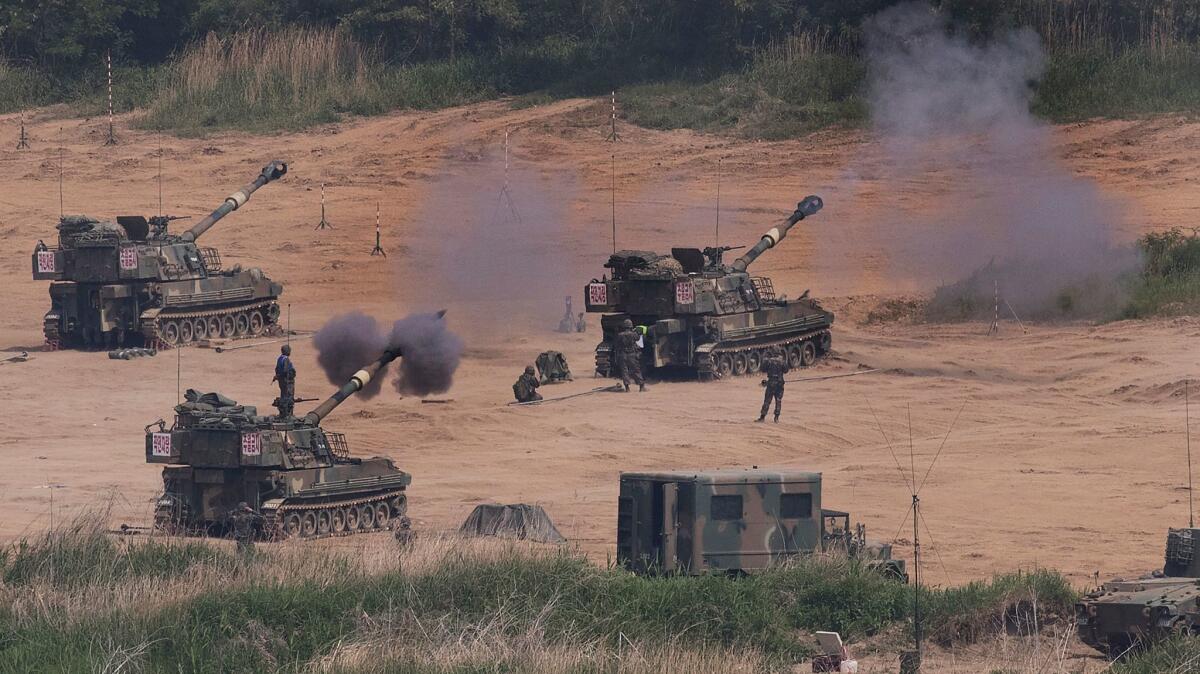South Korea’s military scrambles after unidentified object detected in airspace, renewing North Korean concerns

Reporting from SEOUL — North Korea may have launched an unidentified object across its southern border on Tuesday afternoon, leading South Korea’s military to fire warning shots — a potential new provocation amid already heightened tensions between the two countries.
The incident, which is still being investigated by the South Korean military and could be a false alarm, comes two days after the North test-fired a ballistic missile into the sea — the rogue regime’s latest violation of U.N. Security Council resolutions and further evidence of its advancing weapons capability.
Details about Tuesday’s incident were still unclear, but it was reminiscent of a case in January 2016 in which a North Korean drone flew over the Military Demarcation Line, the border defined by the decades-old armistice signed by the two nations.
The object on Tuesday, less than a mile high, was detected moving slowly by South Korean radar about 4 p.m. local time near Cheorwon, a city in Gangwon Province about 45 miles northeast of Seoul, according to the Joint Chiefs of Staff.
The South sent warning messages and then fired warning shots. There were no reports of injuries or damage resulting from the most-recent incident.
It comes two days after the North deployed a solid-fuel, medium-range missile that flew about 310 miles into the ocean, prompting a strong response from the international community. The missile reportedly flew at a steep trajectory, suggesting its range could have been considerably farther.
Solid-fuel missile technology is a significant step for the regime because such devices can be hidden, transported and deployed more quickly, making them difficult for American and South Korean forces to detect. Liquid-fuel missiles require more time to prepare, in the open, before a launch.
The North’s state media said the successful launch of its Pukguksong-2 missile on Sunday — which in theory could fly more than 1,000 miles — had prompted the nation to decide to mass produce it in the future.
In a news release about the most-recent missile test, the United Nations members called the launch “highly destabilizing behavior and flagrant and provocative defiance” of its resolutions dating back to 2006.
“The members of the Security Council agreed that the Security Council would continue to closely monitor the situation and take further significant measures including sanctions, in line with the Council’s previously expressed determination,” according to the statement.
The North has conducted dozens of missile tests in recent years, and international security experts have tracked the nation’s advancing technical capability. The North already has capability to strike U.S. allies in the region with missiles or conventional weapons, like artillery in South Korea’s case, but the long-term concern is that the North will be capable of putting a nuclear warhead on a missile that can reach a significant American target.
The North has a variety of missiles capable of reaching South Korea and Japan, but it’s building a stable of more reliable devices that could, in theory, strike American military targets in Asia — or someday even the mainland.
In a televised speech earlier this year, the North’s leader, Kim Jong Un, said the country was making progress toward deploying an intercontinental ballistic missile. It’s apparently now a national goal, and the North recently paraded dozens of missiles through the streets of Pyongyang in a show of strength and defiance.
Stiles is a special correspondent.
ALSO
North Korea fires another ballistic missile in latest challenge to neighbors, U.S.
A surprise attack by the Taliban kills 25 Afghan police and spotlights security failures
In a victory for animal rights activists — and dogs — China will ban dog meat sales at festival
More to Read
Sign up for Essential California
The most important California stories and recommendations in your inbox every morning.
You may occasionally receive promotional content from the Los Angeles Times.











